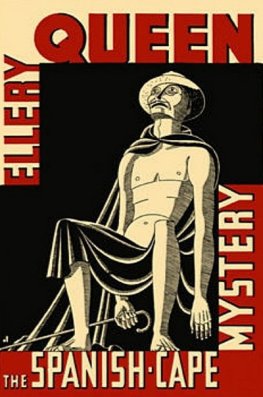Ellery Queen
The Spanish Cape Mystery
Nudaque veritas.
Horace Carmina. I. 24. 7.
THE HOUSEHOLD
Godfrey, Walterowner of Spanish Cape
Godfrey, Stella his wife
Godfrey, Rosatheir daughter
Kummer, David Stellas brother
THE GUESTS
Constable, Laurafat, frenetic, forty
Cort, Earle Rosas fianc
Marco, JohnMesser Diavolo
Munn, Cecilia ex-Broadway
Munn, Joseph A.ex-Arizona
THE CASUALS
Kidd (Captain) a local character
Penfield, Lucius attorney-at-law
Stebbins, Harrya local gas merchant
Waring, Hollis the absent neighbor
THE MENIALS
Burleigh housekeeper
Jorum man-of-all-work
PittsStellas maid
Tiller house valet
(and nameless others)
THE INVESTIGATORS
Macklin (Judge)a vacationing jurist
Moley (Inspector) the local law
Queen, Ellerythe incorrigible logician
THE SCENE
Spanish Cape, a peculiar coastal formation on the North Atlantic seaboard; and environs. The Cape, an outthrust headland of sheer rock about a square mile in area, is connected with the mainland by a narrow tongue of cliff. Although it is only a few hundred yards from a wide motor highway and is flanked by public bathing beaches, it is utterly private and virtually inaccessible.
In the course of the five years or so during which we have had the pleasure of publishing Mr. Queens novels, hundreds of inquiries have been addressed to us demanding an explanation both for the mystery surrounding and the identity of the gentleman who has invariably written the forewords to the Queen books. We regret that we cannot satisfy our correspondents. We do not know.
The Publishers.
I know the place very well, having viewed it innumerable times from the water-side in my modest motorboat, and on at least three occasions panoramically from the air, since Spanish Cape lies on the Atlantic coast directly in the path of a great North-to-South airline.
From the sea it looks for all the world like a gigantic chunk of weathered stone chipped out of some Alpine mother-mountain, sliced roughly down its sides, and plumped into the waters of the Atlantic seaboard to soak its feet thousands of miles from its birthplace. When you get up close to it as close as those devilish sharp rocks encircling its base permit it becomes a granite fortress monstrous in its grandeur, impregnable, and overpowering as Gibraltar.
From the sea, as may be imagined, Spanish Cape is a grim and rather chilling object.
But from the air you get an almost poetically different impression. There it lies far below you, a queerly shaped emerald, dark green and mysterious, imbedded in the wrinkled blue moir of the sea. It is thickly powdered with trees and underbrush; from the height of a plane there are only three details which give relief from the prevailing green. One is the sandwhite little beach of the Cove, with its terrace slightly above (although still below the level of the surrounding cliffs in which it is sunken). Another is the house itself, a sprawling and somewhat fantastic-appearing habitation, a hacienda on a grand scale, with stucco facings and patio and Spanish-tile roofs. Yet it is not ugly; merely foreign to the Yankee modernisms about it, like that filling-station which seems so close to it from the air, but which actually is not on Spanish Cape at all, occupying a site on the other side of the public highway.
The third relieving detail is that knife-like sunken road which slashes across the greenery of the Cape, winging straight as an Indian arrow from the public highway down the slender neck of rock connecting the Cape with the mainland, and cutting through the heart of the Cape to the Cove. The sunken road is white from the air and, although I have never set foot on it, I suspect is made of concrete; even at night it glows under the moon.
In common with most of the informed gentry of that stretch of shore I knew that this remarkable rock formation of course it is the result of millions of years of patiently chewing sea was the property of Walter Godfrey. Few people knew more, for Godfrey had always exercised the prerogative of excessive riches and shut himself away from the world. I had never met any one who had actually visited Spanish Cape, which was only Godfreys summer place, until the dramatic events which shook it and its owner out of their traditional isolation; and then, of course, who should the trespasser be but my good friend Ellery Queen! who seems dogged by a curious destiny.
Much as he struggles against it, Ellery is constantly being either preceded or followed by crimes of a violent nature; to such an extent that a mutual acquaintance, more than half-seriously, once remarked to me: Every time I ask Queen out to my shack for an evening or a weekend I hold my breath. He attracts murders the way a hound if hell pardon the figure attracts fleas!
And so he does. And so, in fact, he did on Spanish Cape.
There are many things about the Problem of the Undressed Man as Ellery himself refers to it which are fascinating, outr and downright baffling. It is only rarely in real life that a crime of such peculiar quality occurs in a setting of such extraordinary magnificence. The murder of John Marco, occurring as it did after the Kidnaping-of-the-Wrong-Man, plus the almost weird circumstance of Marcos nakedness, made for a robust poser; and, now that it is merely another successful Queenian adventure in deduction, for a piece of prime reading.
As usual, I consider myself fortunate to have the privilege of acting the herald in this tragedy of violent errors; and, if my friend will forgive me, of strewing flowers once again in the path of his remarkable mental triumph over what, for a long, long time, looked like insurmountable odds.
J. J. McC.
Northampton
Chapter One
The Colossal Error of Captain Kidd
It was to all intents and purposes a sickening blunder. Criminals have made mistakes before, usually as a result of haste or carelessness or mental myopia, and nearly always to their own disservice; ultimately finding themselves, at the very least, contemplating their errors through steel bars and along a dismal vista of years. But this was a mistake for the books.
The whimsically named Captain Kidd did not number among his few virtues, it appeared, the quality of brilliance. He was an unbelievable mountain of a man; and in return for conferring upon him the gift of physical exaggeration it was assumed that his moody creator had penalized him with a paucity of brains. It seemed clear enough at the beginning that the blunder had been Captain Kidds, a development of his pure stupidity.
The pity of it was that this was one criminal mistake which seemed to work no hardship upon the rascal responsible for it, and still less apparently upon the mysterious person for whom this immense and dull creature was pulling the strings. All its consequences, as was evident, were massed upon the head of its victim.
Now, why fate in the incredible person of Captain Kidd should have chosen poor David Kummer for the sacrifice, every one agreed when it occurred (including Mr. Ellery Queen), was one of those cosmic problems the answer to which is swathed in veils. They could only nod in silent despair at his sister Stellas hysterical requiem: But David was always such a quiet boy! I remember... Once a Gypsy woman read his palm in our town when we were children. And she said that he had a dark destiny. Oh, David!
But this is a long hard tale, and how Mr. Ellery Queen became involved in it is another. Certainly, as a laboratory microscopist peering at the phenomena curiosa of the human mind, he had cause in the end to feel grateful for Captain Kidds grotesque mistake. For when the light came, as it did after those wild and astonishing days, he saw with etching clarity how essential to his solution the gigantic seamans error really was. In a sense, the whole fabric of Ellerys thinking came to depend upon it. And yet, in the beginning, it merely muddled things.









![Elleri Kuin - The Dragon’s Teeth [= The Virgin Heiresses]](/uploads/posts/book/924278/thumbs/elleri-kuin-the-dragon-s-teeth-the-virgin.jpg)




